Lumen sp. z o.o. - unieszkodliwianie odpadów i utylizacja zużytego sprzętu elektrycznego i elektronicznego
Do prawidłowego funkcjonowania strona wymaga zainstalowania wtyczki Flash.
Aby pobrać i zainstalować plug-in Flash skorzystaj z poniższego linku:
Download Flash Player
Do prawidłowego funkcjonowania strona wymaga zainstalowania wtyczki Flash.
Aby pobrać i zainstalować plug-in Flash skorzystaj z poniższego linku:
Download Flash Player
Transportation, claim, disposal of used electric and electronic equipment. Neutralisation of dangerous waste and other than dangerous.
Mercury Hg
| Toxicity class: | harmful material |
| Fire risk class: | incombustible material |
| Self-igniting group: | incombustible material |
| Potential explosion class: | metal’s evaporation doesn’t create explosive mixture with air |
Mercury is protoplasm poison. It enters living organisms through skin and breathing system. The most dangerous state of mercury is fume, even the lowest concentration of it at normal temperature might cause bad poisoning. Reasons for soil and water contamination could be: usage of fungicide containing mercury in agriculture, uncontrolled emission of industrial dust and improper treatment of waste.
Easy assimilation of mercury’s compounds by living organisms causes their high concentration, which in some cases might be a threat of some species extermination. This occurrence is even more dangerous for human beings as many of these species belong to our alimentary chain. Mercury accumulation is a progressive process and its concentration, for example in fish tissue, could be hundreds times higher then in surrounding environment. Consumption of mercury contemned fish has been a death’s reason of thousands of people , mainly in Japan , USA , Canada and Scandinavian countries.
It’s not possible to stop totally mercury emission to environment. Only 30-40% of its compounds goes to environment as a result of human action. But it seems that this particular part disturbs eco-system , the more so as human beings cause concentrated emission to relatively small areas.
Sources of mercury emission to environment could be divided into two main groups. Firstly it is natural emission from soil through natural processes i.e. hollowing out by rainfall. Second group is a complex of factors cause by human interference. Ploughing agriculture lands, burning solid fuel and generating mercury - containing waste are only some examples. The most harmful for environment is storing away mercury’s compounds containing waste. It creates situations, which are dangerous for human beings as well as for zoology and botany world in the nearest surrounding of a waste damp.
Mercury Lamps.
Particular examples of above described waste are mercury lamps , fluorescent tubes and mercury batteries. Worldwide , huge production of lamps and batteries and their common use in households and operations make a total neutralization of waste products not easy.An optimum control scheme of waste products managements is a global solution on a scale of a whole country. Coexisting of rules system which should be defined strictly by precise law and ecological society awareness is necessary. The part which would seal up the system would be a professional utilization establishment.
From the law point of view building such an establishment for neutralization of mercury’s compounds containing waste is particularly harmful for environment.
An investor has to fulfill some basic terms:
- use the best possible technology.
- reduce to a minimum potential conflict situation, which might cause loosing resources or lowering their quality for other environmental users.
- eliminate potential health threat.
- reduce social costs of environmental resources adjustment and adaptation to be done for utilization plant.
The first basic term technology which ensure the highest quality of neutralization used fluorescent tubes - is fulfilled by a machine EKOTROM-2 model 97. It is modernized version of model 95. A construction of this machine guarantees full safely work and environmental harmless.
The machine and its technology are patented , with a patent no 2050051. It has obligatory safely work, ecological and sanitary certificates.
Neutralization (Hg purification) of lamps consists of following unit processes:
- vibratory crumbling (breaking)
- segregation of luminophore from Hg , metal parts (aluminum luminare) and broken glass
- hydro mechanical treatment
- collecting Hg with luminophore , metal parts and broken glass
Description of technological process.
Reloading of whole, cleaned lamps from transporting container to a feeder installed in the machine EKOTROM-2 is done manually. It allows a final lamps quality control and possible selection. From this moment a fully-automatized process of demercuration starts.The feeder places a lamp in a pipe, loading sluice. Hermetical valve, immediately after the lamp goes through, is automatically closed. During demercuration process, under pressure is generated by vacuum pump. The lamp, after being aspirated inside the machine, is crumbled. Size of each glass fragments doesn’t exceed 10x15 mm. Aluminium luminaries are separated from glass on vibrating ruddles and carried away to a container.
Luminophore which contains mercury is aspirated from glass, which after being purified, is collected in a container.
Air stream is purified from luminophore and Hg fume during following stages :
- a cyclone (effectiveness 95%)
- a conveyor filter (effectiveness 99.6%)
- a cased filter (effectiveness 99.98%)
- a basic absorber - 0.01-0.02 mg/kg
- a sanitary absorber - 0.002-0.003 mg/kg
Purification of conveyor filters from an excess of luminophore is done by compressed air.
Used active coal, dust, and water, which contains chemical agents after being used to rinse the machine , are mixed with cement and Na2S and formed into blocks . Mercury contents in the blocks doesn’t exceed 1%.
Generally saying, linking Hg with Na2S turn mercury into insoluble HgS, which tension is disregardful in comparison to fume tension of Hg in metallic form. The producer guarantees that 100 % generated during the process luminophore and used active coal would be receipted by mercury processing plants. Both broken glass and aluminium frames are valuable , regenerated materials.
Description of technological norms.
| Name of indicator and apparatus | unit | value |
Apparatus for lamps fragmentation and lamps components segregation:
|
kPa
kPa |
0.04-0.06
5-15 |
Filter for mechanical cleaning of an air stream after passing through fragmentation chamber:
|
kPa
|
10-20
|
Coal absorber:
|
kPa
|
10-22
|
Vacumm pump:
|
kPa
kPa |
12-25
>40 |
Container:
|
mm
|
>1800
|
Air container in the vacuum pump:
|
kPa
|
25-35
|
Parameters of the post utilization material:
- aluminium frames < 2.1 mg Hg/kg
- broken glass < 1.7 mg Hg/kg
- gas pipe with vacuum pump < 0.0003 mg Hg/m3
Dispersal of post utilization material during neutralization of 6,000,000 lamps - 1800 mg (yearly capacity):
- luminofhor – 60 Mg
- aluminium frames 36 Mg
- broken glass – 1704 Mg
Characterization of neutralized lamps, raw material and electrical power
| Name | Obligatory indicators to be controlled before use in the production | Remarks |
| Used lamps contain mercury | Lamps should be whole, dry and clean,flask diameter up to 42 mm | |
| Compressed air from industrial system (optionally from mobile air-compressor) | Pressure not less than 0.4 MPa | |
| Electric power from industrial system | Voltage 380 V, frequency 50 Hz | |
| Activated coal | Humidity not more than 15% | carbon filter of mercuryx |
Operating Personnel
- Technical supervision
- A production manager
- A technologist
- A dispatcher
- Workers
- 2 apparatus workers
- An iron worker for renovation
- An inside transportation worker
Danger connecting with the machine’s exploitation:
- A possibility of contacts with mercury
- Existing of moving parts in a vacuum
- Emission of noise during vacuum pump work
- Possibility of collar connections in an air channel, which contains Hg fume
Considering safety work rules:
- a cover next to a vacuum pump feeding joint
- sealing of fittings
- a system of fenced stairs (depending from the machine’s localization)
- Use of under-pressure, which makes unable unorganised emission to atmosphere
- Deadening facility on the vacuum pump feeding joint
- Net of earth connections
- An automatic signalling and a regulation of a technological process disturbances
- Damage feeding from a distributing control board
Exploitation requirements
- A state of working filters to be controlled unconditionally after 4,000 working hours of the machine, despite of current exploitation parameters
- Changing of a container collecting luminophore to be done after about 40 working hours of the machine or independently after neutralisation of 60,000 lamps
- Contain of absorber to be changed at Hg fume concentration between 0,008 and 0,01 mg Hg/m3 at an emitter , after reaching the level of 0,003 mg/m3 of Hg concentration in emitting to atmosphere gas stream , at least once a week very detailed measurement to be done
- Monitoring of air parameters has to be done everyday, as well after every opening of a gas purification system, an ad sober, filters, a luminofhore container and in damage situations
A scheme of a process
A scheme of a process of mercury transformation and removal from fluorescent tubes
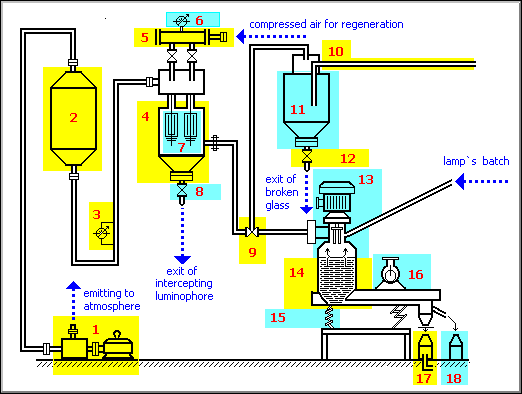

| Picture’s notation | |||
| 1. | A vacuum pump | 10. | A pipe caring out broken glass |
| 2. | An adsober with active coal | 11. | A release valve |
| 3. | A manometer for under-pressure measurements (vacuum) | 12. | Spout valve |
| 4. | A filter for detailed purification | 13. | An electrical motor with a crumbling root |
| 5. | An air container | 14. | A crumblier and segregator |
| 6. | A manometer | 15. | Springs |
| 7. | Filtring element | 16. | A vibrator |
| 8. | A dust valve | 17. | An intermediary container of broken glass |
| 9. | An outlet valve | 18. | A container of aluminum luminaries |
Pictures of the machine
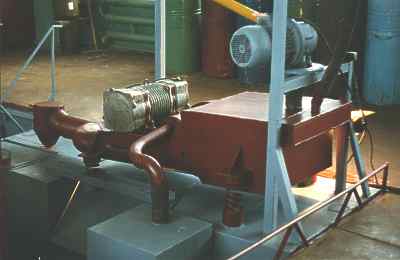
A view on the Crumblier and the separator with the vibrator.
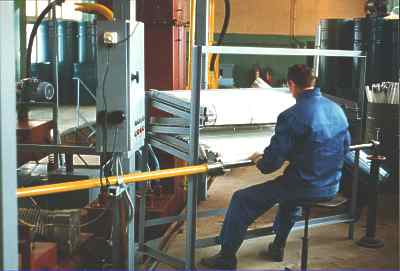
A lamp`s batch stand.
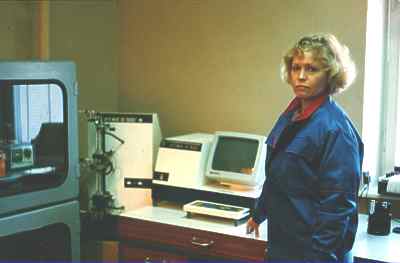
A remote control stand.
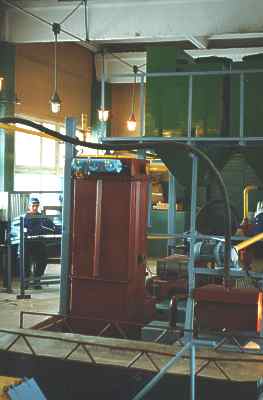
A general view of the machine.


